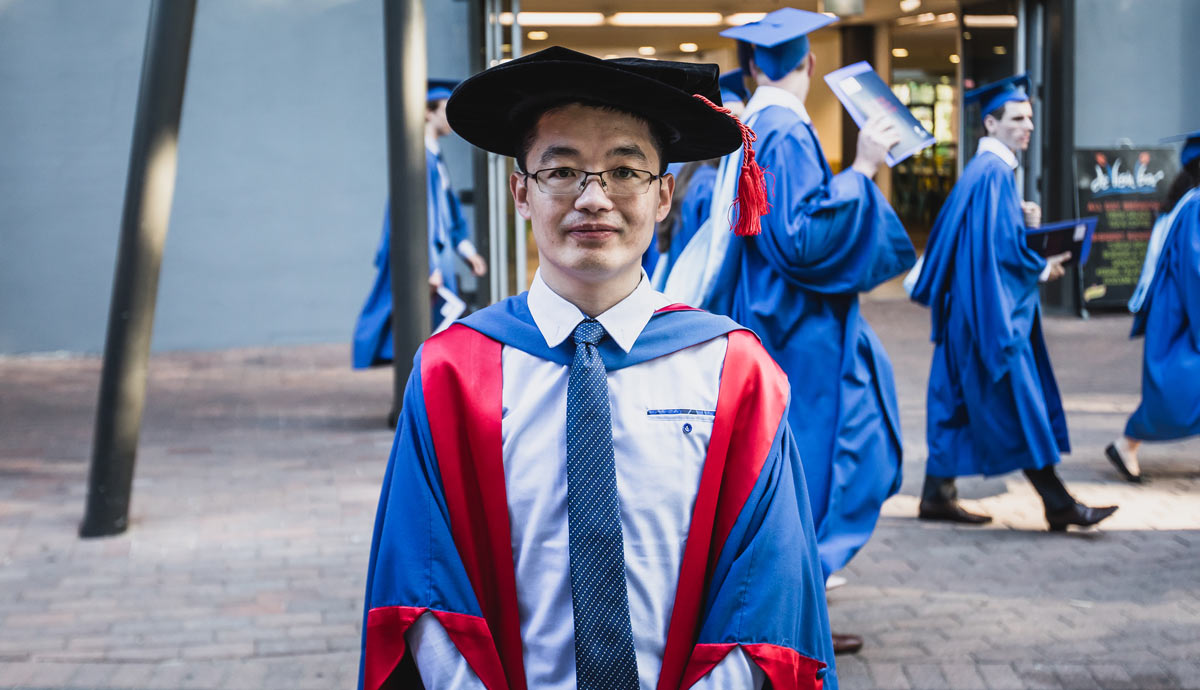April 18, 2018
Fabricating a future where materials science meets medicine
PhD graduate is leading developments in 3D bioprinting and regenerative medicine
When Qi Gu first discovered the wonder of stem cells as an undergraduate student in China, he recognised the field had potential to make a major impact on modern medicine.
Qi was an undergraduate student in China when he heard a lecture about the future of regenerative medicine and how 3D printing could be adapted to deliver new clinical solutions.
He went on to complete his first PhD in 2013 at the Northeast Agricultural University of China, Harbin, where he specialised in cell and developmental biology, but remained fascinated by the idea of new materials incorporating stem cells.
“Stem cells are miraculous and could be used to restore the damaged parts of the body and hold promise in treatments for many types of disease,” Qi said.
The challenge was to combine the disciplines of cell biology with materials chemistry and engineering, so he turned to his first supervisor, Professor Qi Zhou, who put him in touch with University of Wollongong-headquartered ARC Centre of Excellence for Electromaterials Science (ACES).
Certain stem cells, such as human pluripotent stem cells (PSC), are of interest to researchers for their ability to be differentiated into any of the 200 types of cell in a human body.
This not only reduces the chance of rejection in the case of an organ or tissue transplant, combined with 3D printing it enables researchers to fabricate replica organs that help scientists better understand the development of the tissue and interactions of drugs with the tissue.
“New materials are needed to establish the conditions for stem cell survival and functionalisation,” Qi said.
The idea is to make an ink that is compatible with the human body and which carries, protects and nourishes the cells as it goes through the 3D-printing process.
“We developed a new type of polysaccharide-based material, which is gel-like and could be used as bio-ink to accommodate human stem cells.
"The printed gel structure is capable of being customised into human organ, such as brain tissue for 3D research, or other organs for transplantation.
“In order to fabricate an organ, I need to combine stem cells, materials and engineering together. So I turned to a different field to improve my knowledge of materials and engineering, a field in which ACES is well known.”
Qi embarked on his second PhD under the guidance of ACES Director Professor Gordon Wallace and stem-cell expert Professor Jeremy Crook.
“I believe 3D bioprinting will change our lives in the future,” Qi said.
“The organs generated from 3D bioprinting could reduce the need for organ donors and improve the patient experience by avoiding rejection and time-consuming procedures and meeting patient-specific requirements.
"So in the future we will face a new concept of smart regenerative medicine.”
Qi celebrated graduating his second PhD today (Wednesday 18 April), taking a brief break from his lab in China where he’s continuing the work and the partnership with his mentors at UOW and ACES.
“It is an impressive and unforgettable experience studying and working in ACES, which is an international centre with wide vision and professional people.
"I have also made many friends with continuous friendships wherever we are.
“I have learned a lot, not just about science but how to build an effective interdisciplinary research team and how to be a scientist, from my supervisors Professor Qi Zhou, Professor Gordon Wallace and Professor Jeremy Crook.
"I want to thank them for their ongoing support. I will keep in contact with Professor Wallace, Professor Crook and other people at ACES for collaboration and work together to move forward the development of the field we are interested in.”
Great to catch up with soon to graduate PhD student Qi Gu in #Beijing Having completed a PhD in #3dbioprinting @ARC_ACES @uowresearch Now establishing a new lab at Institute of Zoology- Chinese Academy of Science pic.twitter.com/Nvd9mrHjfd
— Gordon G Wallace (@GordonGWallace) April 14, 2018
Since completing his PhD at ACES, Qi has set up his own laboratory in Beijing: Intelligent Biomaterials and Biomedical Engineering at the Institute of Zoology, Chinese Academy of Sciences.
“Currently, China has a few global recruitment programs for innovative talents and pioneers.
"The Institute of Zoology is offering jobs for people with a multidisciplinary background aiming to fabricate functional tissues in-vitro because they are establishing a new institute called Institute for Stem Cell and Regenerative Medicine.
“My interdisciplinary background in biology, chemistry and engineering, and my achievement at UOW, contributed to me being selected for the program.
"My lab is focusing on developing novel biomaterials and advanced technologies, including 3D and even 4D bioprinting, to materials to support the interface between the bio-ink and the stem cell that will enable the fabrication of functional organs that will help us understand the mechanisms of life and establish novel therapeutic methods.”
ACES Director Professor Gordon Wallace said: “To graduate with a second PhD in 3D bioprinting having completed his previous thesis in stem cell research is a truly remarkable achievement.
“I have no doubt that Qi Gu will quickly become recognised as a world leader in this emerging field of science and technology that is bound to have a significant clinical impact"
